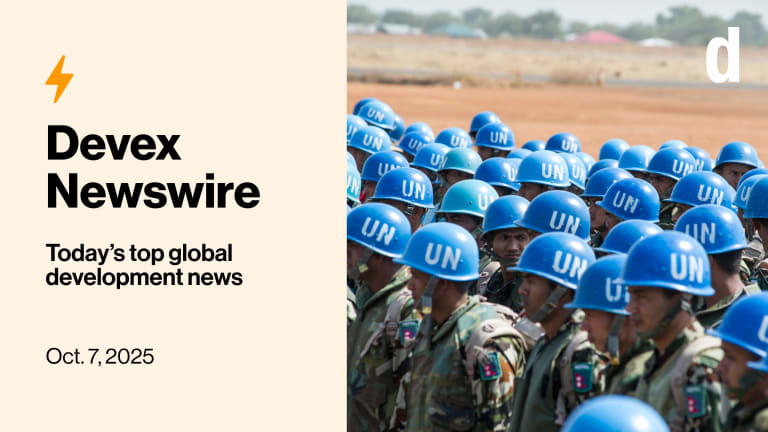Donors could save billions through localization. Here's how
Shifting 25% of ODA would deliver programming that is 32% more cost-efficient, according to a new study, which breaks down the cost savings that would otherwise go to international overhead and salary costs.
There’s a growing consensus within the global development community that shifting international aid and decision-making power to local organizations is the right thing to do. Less is known about the financial argument for localization. A new study attempts to put a dollar figure on these benefits by modeling a shift of official development assistance from international to local intermediaries. It finds that local intermediaries can deliver aid that is 32% more cost effective than their international counterparts, mostly due to lower overhead and salary costs. The study is one of the first attempts to quantify the benefits of localization. It found that if one quarter of the $54 billion in annual overseas development assistance that goes to the United Nations and INGOs went to local intermediaries instead, it would generate a cost savings of $4.3 billion annually. The analysis used a 25% shift in funding to reflect commitments by the U.S. Agency for International Development and Grand Bargain to shift 25% of development assistance to local and national partners. By highlighting these cost efficiencies, the report makes the case that donors are wasting money due to their slow progress on localization. “There are a lot of inflated costs in the system,” said Courtenay Cabot Venton, founder and CEO of The Share Trust, an organization that aims to tackle the systemic barriers grassroots initiatives face globally. “It’s remarkable how much we can save by redeploying funds to local actors,” she added. She presented these findings at an event last week on “the economics of localizing international assistance.” “We know that there’s a very clear ethical argument for shifting more funding to local actors,” she said. “And what we really hope this does is to help to back that up with a very clear financial imperative to do things differently.” In the international intermediary model, official development assistance flows either to the U.N. — which sub-grants to INGO partners, who then sub-grants to local partners — or directly to INGOs, which then sub-grants to local partners. “If we keep advocating for the localization agenda, and we do not tool it, then it is as good as useless.” --— Naomi Ayot Oyaro, Local Coalition Accelerator Uganda coordinator Because of the scale of their giving, most bilateral donors are unable to make direct investments to thousands of local organizations, Cabot Venton explained. But local intermediaries, which bring local and national partners together, can help donors channel funds to groups working in closer proximity to development challenges. An example is the Local Coalition Accelerator, which The Share Trust launched in 2020, building on their experience supporting self-help groups around the world. Its mission is to support local and national organizations to access bilateral and multilateral financing that makes up 93% of official development assistance. Launched in partnership with Warande Advisory Centre, the model is being implemented in Nigeria, Bangladesh, and Uganda. The Warande Advisory Centre produced the study in partnership with The Share Trust. Naomi Ayot Oyaro, who coordinates the Local Coalition Accelerator in Uganda, says the group is working with local organizations in Uganda not just to build capacity around specific projects, but to improve systems in areas like grant management, so that they can “do more work in the community.” “That is the right way and the moral way to enable local actors,” she said at the event, which was hosted by the Center for Global Development. “If we keep advocating for the localization agenda, and we do not tool it, then it is as good as useless.” Many donors would say that local partners are risky, simply by virtue of being in, say, Uganda, but they are not “tooled to be less risky,” Oyaro said. Cabot Venton wanted to ensure that she was modeling “an equitable system.” International staff typically make six times what local staff make. The report models paying local partners 3.7 times what they currently make, adjusting salaries only for the cost of living, and paying both INGOs and local and national organizations 18% overhead or indirect support. “What we don’t want to be saying is that it’s ‘loads cheaper’ to send money to local intermediaries because we don’t have to pay them as much and so therefore we’re going to save a whole bunch of money,” she said. Localization is not only cost-efficient, but also cost-effective, Cabot Venton said. Local partners are trusted by their communities and are able to ensure the most vulnerable are reached. They’re also in a unique position to respond quickly, pivot, and address the changing needs of the people they serve. But even with this compelling case for cost-effectiveness, which builds on the moral argument for localization, there is sure to be pushback from the organizations that benefit from the current system — such as the 25 organizations that received 60% of USAID’s funding in the fiscal year 2017. One possible way forward would be for donors to work with more governments and multilaterals, channeling funds through them, instead of U.N. agencies, international NGOs, or individual transactions with thousands of local organizations, said Justin Sandefur, senior fellow and co-director of the education program at the Center for Global Development, which hosted the event. He also acknowledged several challenges facing the localization agenda. One was “the elephant in the room,” whether switching from U.S. contractors to local contractors means trade-offs in terms of outcomes. Local organizations may not have the same technical capacity for certain priorities, so funders need to determine which activities do or do not make sense for them to take on. “Advocates like myself of localization can’t just wish away any trade-offs there, and we need to really show that we can maintain development effectiveness,” Sandefur said. Another challenge is feasibility and scale, he said, explaining that it would be hard to rebuild Ukraine with small NGOs. There’s also the problem of “gaming of what is local,” with organizations creating “shadow entities in developing countries,” he said, offering the example of working with Deloitte Tanzania instead of Deloitte USA. Cabot Venton said she’s spoken with many of these 25 organizations since publishing the study in November. Most are clustered in or around Washington, D.C. “The system is too expensive and too broken,” she said. “We can’t keep operating the way that we are if we’re going to achieve the goals we’ve set out to achieve.” The large organizations that benefit from the current system aren’t disappearing, Cabot Venton noted. Even in this modeling, they’d still get 75% of the resources, and they will continue to play an important role, she said. But many of them seem to see the writing on the wall when it comes to localization, she said, and they are already beginning to make changes. “Bilateral donors are starting to recognize it’s a risk-return trade-off,” she told Devex. “If you’re avoiding risk, but you’re paying through the nose for it, there’s a certain point where that balance starts to tip.”
There’s a growing consensus within the global development community that shifting international aid and decision-making power to local organizations is the right thing to do.
Less is known about the financial argument for localization.
A new study attempts to put a dollar figure on these benefits by modeling a shift of official development assistance from international to local intermediaries. It finds that local intermediaries can deliver aid that is 32% more cost effective than their international counterparts, mostly due to lower overhead and salary costs.
This story is forDevex Promembers
Unlock this story now with a 15-day free trial of Devex Pro.
With a Devex Pro subscription you'll get access to deeper analysis and exclusive insights from our reporters and analysts.
Start my free trialRequest a group subscription Printing articles to share with others is a breach of our terms and conditions and copyright policy. Please use the sharing options on the left side of the article. Devex Pro members may share up to 10 articles per month using the Pro share tool ( ).
Catherine Cheney is the Senior Editor for Special Coverage at Devex. She leads the editorial vision of Devex’s news events and editorial coverage of key moments on the global development calendar. Catherine joined Devex as a reporter, focusing on technology and innovation in making progress on the Sustainable Development Goals. Prior to joining Devex, Catherine earned her bachelor’s and master’s degrees from Yale University, and worked as a web producer for POLITICO, a reporter for World Politics Review, and special projects editor at NationSwell. She has reported domestically and internationally for outlets including The Atlantic and the Washington Post. Catherine also works for the Solutions Journalism Network, a non profit organization that supports journalists and news organizations to report on responses to problems.








